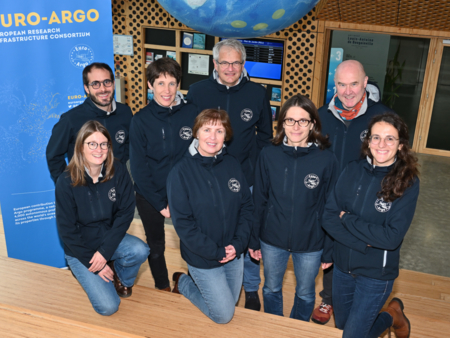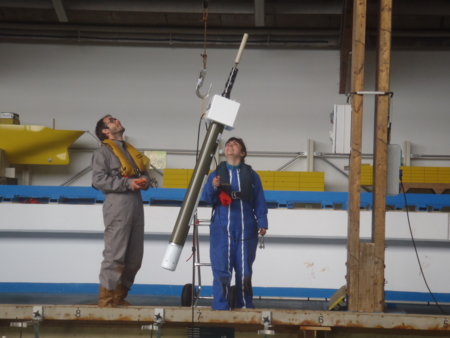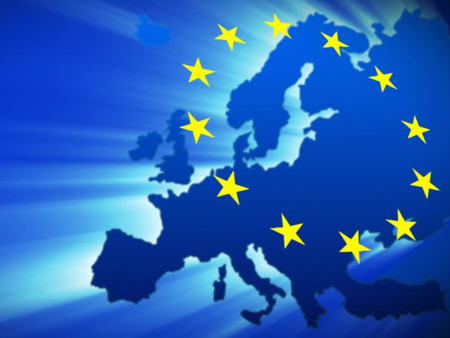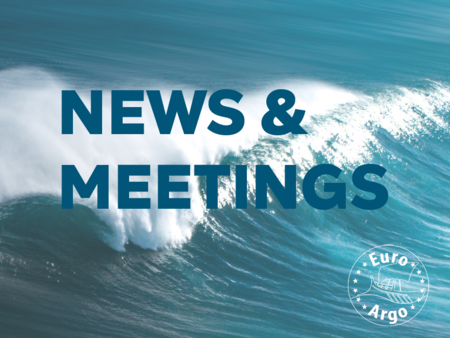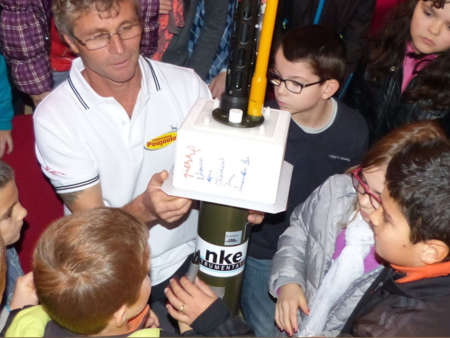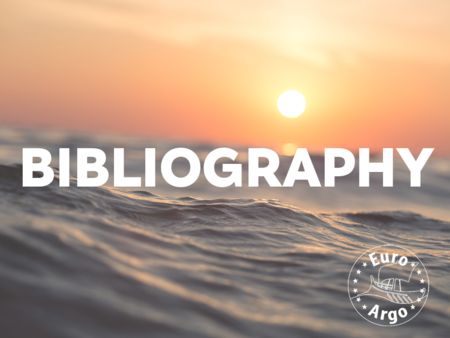Euro-Argo RISE progress: already halfway there!
Since this summer, the work has been progressing on the 4 main pillars. This newsletter presents the main achievements from July to December 2020, e.g until month 24 (of 48).
What are the main achievements?

Goals | Concrete results |
Diversify providers to secure sensor provision at a competitive cost in order to sustain and expand the network. | - Testing RBR sensor for Core:
- Publication of an article on the accuracy and the long-term stability assessment of an RBR CTD inductive conductivity cell on Argo floats.
- Successful deployment by Ifremer of 2 Arvor-I floats with RBR CTDs in the Canary Basin in collaboration with IEO during the RAPROCAN2012 cruise in mid-December. The analysis of the first data acquired has just started.
- Testing accuracy of sensors for Deep:
- Two 3-headed deep-Arvor floats (equipped with SBE41, SBE61 and RBR concerto sensors) were successfully tested by Ifremer in the seawater pool in mid-November 2020. The floats were deployed in the Canary Basin in collaboration with IEO during the RAPROCAN2012 cruise in mid-December.
- Testing new BGC sensors:
- Irradiance dual-sensor prototype ready to be deployed by FMI for the scientific experiment in the Baltic Sea.
- Processed data of the nitrate dual sensor prototype by SU indicated that accuracy and precision of the NO3 retrieval for Opus sensor do not have the required maturity yet for being implemented for an operational deployment. Technical work with the manufacturer will continue outside the project.
|
Test Argo closer to the shallow coastal waters to evaluate its potential use in Marginal Seas. | - Preliminary results from targeted Argo missions in the Baltic Sea by IOPAN and FMI, and in the Mediterranean Sea by HCMR, OGS, SOCIB and SU have been received. Following the successful deployments of Argo floats in shallower waters, the analysis is ongoing to highlight the importance of Argo expansion in the shallow coastal areas and develop a European strategy.
- Publication of a paper on Argo floats in the southern Baltic Sea by IOPAN highlighting the opportunities offered by Argo observations to measure the dynamics of dissolved oxygen in this area.
|
Enhance Argo coverage in the high latitude areas | - Deployments of floats with Ice Sensing Algorithm West of Spitsbergen by IOPAN, North of Spitsbergen by BSH, in the Barents Sea by FMI and IMR.
|
Provide configuration recommendations to increase the overall performance of the fleet. | - Development of tools to better monitor configuration parameters throughout a float lifetime by Euro-Argo ERIC. Study is ongoing to identify the optimal float configurations to enhance float life expectancy. Collaborations with WP6 are underway to work on configurations in Marginal Seas for operations in shallow coastal waters.
|

Goals | Concrete results |
Develop new regional partnerships and engage with new users. | - Collaboration with Estonia established by IOPAN for a recovery of a Polish float in the Baltic Sea.
- Presentation of the Argo float operations within Euro-Argo RISE activities for the Baltic and the Mediterranean Seas respectively at the BOOS annual meeting by IOPAN/FMI and the MOONGOOS General Assembly by OGS.
- Promotion of the future events for the Marginal Seas (Mediterranean & Black Sea workshop, Political event, Arctic & Baltic workshop) to the MOONGOOS and BOOS communities.
|
Engage with new countries to develop national programmes and ultimately increase the Euro-Argo ERIC membership. | Preparation in the entry of Portugal as a Member: 1st deployment in the Gulf of Cadiz of 2 Provor-DO on a French navy (SHOM) cruise in October 2020 following IPMA recommendations after floats preparation by Argo France. |
Increase awareness among younger generations of the importance of ocean observations for climate change research. | - Development and release of a new Argo app for Android smartphone by Ifremer in November 2020.
- New features developed by OceanOPS for the 3D Argo discovery and display tool (depth filter and class repartition chart).
- Specific interactive classes of the Argo online school are under preparation by IEO to explain the Argo programme and access to the data.
|

Goals | Concrete results |
Ease access to Argo data and increase their usage. | - Beta-version of the new Argo data selection tool developed by Ifremer was presented at the ADMT-21 by Euro-Argo ERIC (Euro-Argo RISE / ENVRIFair project synergies).
- Argo online school developments: Hand-on lessons are under preparation by IEO. They will explain the minimum requirements to use and understand Argo data (see here)
|

Goals | Concrete results |
Improve and share DMQC procedures and materials for core Argo. | - Publication of the Python library for Argo data analysis, Argopy, by Ifremer in September 2020.
- Euroargodev collaborative framework was officially introduced by Ifremer to Argo international during the ADMT-21 meeting in December 2020.
- Several Argo DMQC initiatives on softwares, reference datasets and shared expertise through a cookbook carried out within the project were presented by Ifremer and BODC and endorsed by the international community during the ADMT-21.
|
Improve the BGC data processing workflow at the European level. | - Submission of delayed mode data to the GDAC when available in the laboratories.
- Development, test of new methods for adjustment in Real-Time and implementation at Coriolis on a large set of European floats.
- Development of delayed mode procedure and presentation of the results to Argo international at the BGC ADMT in December 2020 by SU, Ifremer, GEOMAR/IOW and PML.
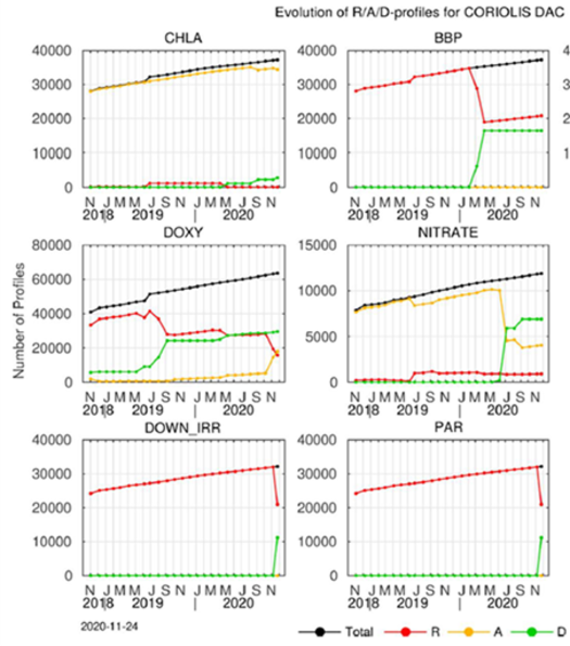
|
Enhance data quality for EOVs. | Progressive involvement of the European BGC community to the euroargodev collaborative framework that has been extended to BGC methodologies and tools. |
Conclusion:
The end of the year 2020 has been productive for European partners on improving the core Argo mission and extending Argo to the new Argo mission with a key milestone that was the Argo Data Management Team meeting. More results and meetings are on the way for 2021: stay tuned!
Deliverables
During this period, 8 more deliverables were produced and submitted to the EC:
Workpackage | Deliverables |
WP2 | D2.1 Enrichments of monitoring tools to track and compare float configurations and estimate life expectancies  D2.1 D2.1 D2.2 RBRargo|2000 OEM sensor and float experiment description  D2.2 D2.2 D2.3 A European strategy plan with regard to the Argo extension in WBC and other boundary regions  D2.3 D2.3 D2.5 Report on the implementation of a collaborative DMQC toolkit  D2.5 D2.5 |
WP4 | D4.1 Realisation of two dual sensors floats prototypes for nitrate and irradiance  D4.1 D4.1 |
WP6 | D6.1 Tailoring of the controlling and monitoring tools for operation in shallow waters  D6.1 D6.1 D6.2 Preliminary results of shallow coastal float operations in the Mediterranean Sea  D6.2 D6.2 D6.4 Preliminary results of shallow coastal float operations in the Baltic Sea  D6.4 D6.4 |

